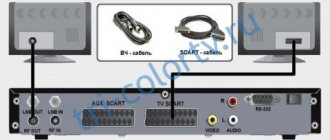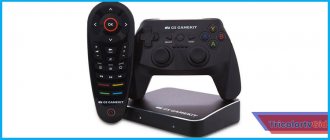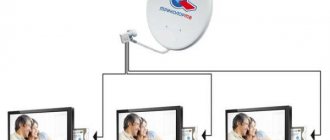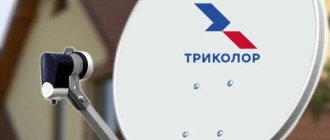The work of satellite television is to receive, process and further transmit a special signal to the satellite. This process becomes available if you have special receiving equipment - a receiver issued by the Tricolor TV operator when you subscribe to a number of services. Users often come across the question: “How to connect a second TV to Tricolor TV without a second receiver?” This is related to the desire to expand the basic capabilities of television and significantly save on purchasing additional services.
In this material we will look at how to connect one set-top box with several TVs with our own hands in 2021. Also, a similar service is offered by Tricolor, which will also be given attention.
Two sets and double payment
The simplest solution that comes to mind in this case is to purchase a couple of sets of equipment (or buy a second one if you already have one), and connect two Tricolor TV services to both receivers. The option can be confidently called full-fledged, since it allows you to watch TV completely independently, and it will not matter how far away they are from each other. However, this method has significant disadvantages:
- costs will be required for installation and connection of additional equipment;
- on the facade there will be two tricolor antennas at once (as an option, you need to purchase a converter with two outputs and a dish with a larger diameter);
- You must regularly pay a double subscription fee.
Those who cannot afford or do not like this implementation are looking for other cheaper ways to install Tricolor TV on 2 TVs.
Two TVs, two receivers and one antenna
Domestic craftsmen, of course, tried to solve this problem. Their proposal is to purchase another receiver (simpler and cheaper) and “halve” the signal on the way from the antenna to the set-top boxes. A satellite divider (splitter) is used for this. The diagram looks something like this:
But this option also has its serious drawbacks:
- when buying a second receiver, a dilemma arises - new models are not cheap, and old ones cannot support signal transmission in new formats;
- it will be necessary to register both devices in the Tricolor TV system, which means you will have to pay double the subscription fee;
- Receiver software becomes outdated over time, and during the flashing process, problems in the parallel operation of receivers cannot be ruled out.
The best option for connecting a satellite dish to several TVs
To watch different TV channels on 2 (3, 4, etc.) TVs, you need to connect a separate tuner to each of them. But such an elegant cable solution is very expensive.
You will need 3 separate cables, from the converter (“antenna head”) to each receiver - a separate cable. For this, there are special converters with different numbers of outputs - 2, 4, 6, 8. Accordingly, if you want to connect satellite TV to 3 TVs, you will need a converter with 4 outputs.
Splitter
It is considered the most financially profitable way to connect. The signal can be received from any satellite, but such a system will not always work acceptable.
Multiple output converter (LNB)
There are several modifications of this element, each with a different number of outputs - 2, 4, 8, 16. Each TV needs a receiver, or the TV must have a built-in DVB-S2 tuner and a CI+ slot for the CAM module. A separate cable is pulled from the converter to each TV.
There are convectors of the C and Ku ranges. All paid satellite television operators operate in the Ku-band. Ku-band satellite converter (LNB) is divided into:
- circular (“Tricolor-TB - Siberia”, “HTB-Plus-Vostok”) polarization;
- linear (“Continent-TV”, “Orient Express”) polarization.
This type of convector is considered the most reliable connection option with a minimum number of connections.
ST for several TVs
There is another option for connecting multiple TVs to multiple satellites. If it is necessary to connect a large number of subscribers to one antenna, then a special device is used for this - a multiswitch, which divides the signal into several convectors. Most often, this element is used to create a network with a large number of users (for example, in urban apartment buildings). If you need to connect CT to several TVs in a private cottage, then it is more convenient to use convectors with independent outputs.
CT from several satellites to several TVs
For this connection option, in addition to convectors with independent outputs, devices such as “diseks” (“daiseki”) are also required. They are designed to receive signals from different satellites via one cable. Dishes are adapted for different protocols. The protocol standard for which a particular drive is intended is indicated on the packaging or on the device itself. For example, “DiSEqC 1.0 – up to 4 convectors.” For the entire system to work, the receiver must also support the standard for which the disc is selected.
Two TVs from one Tricolor TV set-top box
This is an alternative for the most economical and those for whom it is not important that both TVs show different channels. If you look closely at the rear panels of the receivers, you will see not one, but several outputs at once, intended for broadcasting the decrypted signal. Alternatively, these could be HDMI, AV (RCA), SCART, RF AUT connectors. The presence of several sockets allows you to make a “fork” for two monitors (adapters can be used if necessary).
For example, the newest plasma can be connected to the receiver using an HDMI cable, and an older model can be connected to “bells”. After this, you need to configure the receiver to receive the channels of the connected packages.
Here is one option for such a connection:
Or you can do this:
Important: with this connection option, both TVs can only show the same channel at the same time, since they receive the same signal from the receiver. You can switch (as well as turn on and off) the receiver only in the room where it is installed.
When implementing such a solution, it is also worth considering that only a high-frequency (television) cable, which is connected to the RF AUT output on the receiver, is capable of transmitting a signal over significant distances. In cases where other plugs and connectors are used, the TVs can be no further than 10 meters from each other, otherwise there will be interference.
If there is no such socket on the rear panel of the receiver, and the TVs are supposed to be installed far from each other, you cannot do without an external RF modulator. It connects to the receiver via “bells”, then you can connect either one of the TVs or a signal divider to it. Accordingly, the installation price will increase in this case by the cost of one or both devices.
Satellite TV for several TVs
Receivers for connecting two TVs
If one of the devices has not only an input, but also an output socket for an antenna (not to be confused with a modulator socket - it is designed to connect the device to a TV via high frequency), then you can connect a cable to this socket, which is designed to connect satellite antennas to receivers . Connect the second end of the cable to the input jack of the second receiver. You will get a serial connection of the converter and two receivers. If you receive encrypted channels, you will have to purchase a separate card for each receiver and pay a subscription fee. In addition, with such a connection, it will not be possible to watch channels with vertical polarization on one receiver, and with horizontal polarization on the other.
With this connection, the slave (second) receiver must be configured so that the “Power” option is disabled. Otherwise, problems may arise when viewing channels.
This connection option makes sense when the user wants to use one TV, for example, only for watching paid channels, and the other for free ones.
You can use a splitter that is designed for satellite receivers and converters. This connection method will have the same disadvantages as the previous one. Additional equipment must be used if none of the receivers has an output jack for connecting a second device.
Installation of 2 converters on the antenna
If you install 2 converters (“heads”) on the antenna, you can connect them to two different receivers. They will work independently of each other.
But there is such a drawback: 2 converters cannot be directed to one satellite. You will have to watch different channel packages from different satellites. If the channels are encrypted, you will have to purchase 2 cards and pay 2 subscription fees.
Installing a converter with two outputs
Another option is a converter with two outputs. One of them can receive channels with vertical polarization, the other - with horizontal polarization. Both outputs need to be connected to a multiswitch, and parallel cables should be drawn from it to the TVs. On any of them you can watch channels that are broadcast in any polarization. All required switchings will be automatically made by the multiswitch. But for each receiver you will need a separate card and subscription fee.
If you want to use one receiver and one card, and the receiver has a high-frequency modulator, then you need to connect the modulator output to two TVs through a splitter, which is designed for terrestrial antennas. Both TVs need to be tuned to the satellite TV channel that the modulator broadcasts. When you change the channel on the receiver, it will simultaneously change on both TVs.
You can connect one TV at a low frequency (for this you will need RCA or SCART connectors), and the second at a high frequency (for example, through a modulator). The result will be the same, but with this connection, you can connect a regular indoor or outdoor antenna to the first TV and independently receive over-the-air channels. And if one TV is connected via RCA, and the second – via SCART, then you can watch channels from a regular antenna on both TVs.
You can connect satellite TV to two TVs and through one receiver. In this case, the first device is connected to the first TV using a “tulip”, and the RF module is connected to the second output on the tuner, which is intended for connecting other monitors.
This method has many disadvantages. You can only change channels in the room where the receiver is located. And the main drawback is that both TV receivers show the same channel.
Special offer from Tricolor - set for two TVs
For those who are not satisfied with this option, the National Satellite Company offers its solution to the problem - purchase a Tricolor set for two TVs. As practice shows, this is the most optimal choice, which allows you to respect the interests of all family members without significant material costs.
Read: how much does it cost to connect and use satellite Internet from Tricolor TV.
We advise you to find out how to watch Tricolor television on your computer online.
What is a set for two TVs from Tricolor TV?
The most complete set, which will allow new subscribers of the operator to do “everything right” at once, includes:
- satellite dish equipped with a converter with two outputs;
- dual-tuner receiver GS E501 (or other similar models);
- client set-top box GS C591 (GS C5911 or GS C592);
- 2 remote controls and 2 power supplies (one for each device);
- smart access card;
- coaxial cables for connecting to the antenna;
- twisted pair cable (connects the set-top box to the receiver);
- HDMI cables for connecting TVs to set-top boxes;
- documentation and instructions.
The average price of such a Tricolor TV set for 2 TVs, including installation from official dealers of the satellite operator, at the end of 2017 fluctuates around 12-14 thousand rubles. Doing the installation yourself will cost about 2 thousand rubles less.
Tip: if your home already has a modern two-tuner receiver, you can purchase a client set-top box separately. It costs less than a full-fledged receiver, but you will need to pay extra to the operator for the viewing service on two TVs. In addition, the operator offers to exchange existing outdated equipment for such a set at an additional cost.
It is also not necessary to install a dual converter on the antenna instead of a single output head. It is enough to install an antenna divider when the coaxial cable approaches the receiver. You can learn how to do this correctly from the video at the end of the article.
How does a set of two consoles work?
The principle of connecting all devices into one system is simple and clear. A smart card is installed in the main receiver (GS E501) - there is only one in the kit. Two coaxial cables (from the two outputs of the antenna converter) are connected to the LNB IN 1 and LNB IN 2 inputs on the same receiver.
The device also acts as a server. It will decrypt the signal and transmit it to the GS C591 client set-top box using a “twisted pair”, the ends of which are connected to the Ethernet connectors on both set-top boxes.
Then all that remains is to connect the TVs to the set-top boxes using HDMI cables (SCART connectors are useful for older models) and search for channels.
Tip: you can configure both set-top boxes to correctly display the signal using the detailed instructions that come with the kit, or using the tips from the video:
If everything is done correctly, and the corresponding Tricolor TV services are paid in advance, both TVs will show channels in offline mode.
Receiver GS E501/GS C591 on multiple devices
For the connection process to be successful, you should configure an antenna that has a converter with a pair of outputs. The coaxial cable allows you to mount the GS E501 (server) connectors with the converter together. The equipment set usually includes twisted pair cable. In case of absence, pinout is done manually.
Then the SIM card is inserted into the card reader accordingly. All actions are performed exclusively on a de-energized device. The setup is as follows:
- The “Setup Wizard” prompts its client to select the language and video format. In this list you can configure the visibility frame for the screen. All actions are performed using a remote control. After completion and clicking “forward” we get to the following parameters;
- Here you need to fill in the time and date (automatic mode or manual setting), then wait “forward”;
- The establishment between the server and the client occurs over the local network. To begin, the “Ethernet 0” menu must be activated. There are two options: connecting with an Ethernet cable, then “Link Local”; using a router - “DHCP”. Click “OK” and turn the switch to the “On” state. Click exit and automatically return to the original menu, click “Search”;
- Next, a window with settings will appear, where you need to decide on the operator depending on your place of residence. There is the quality of tuning of the installed antenna in the lower corner. Save the selected parameters and move on to step 5;
- Select the region and confirm by clicking “OK”. As a result, a message indicating the successful completion of the action will appear;
- Save the result by clicking “OK”. The setup is complete.
Thanks to Tricolor TV, Russian residents will be able to watch different programs on several units simultaneously, using just one Tricolor MultiStart card.
Summing up
Several options for connecting a pair of TVs are being considered. In the process of choosing one of them, you will need to carefully weigh all the negative sides and advantages of the method. It is advisable to adequately assess the strengths and general capabilities and quickly check the general technical characteristics of the set-top boxes and televisions available. After determining and selecting the optimal option, you will need to sketch out a special diagram for the location of devices and numerous connecting wires. This is necessary to accurately calculate the length of all wires.
Minimum requirements for successful implementation of the plan
Interactive TV today is offered to Russian citizens by various companies, in particular Rostelecom. Thanks to this service, owners of city apartments and country houses receive the following opportunities:
- view a large number of channels in perfect quality;
- record the programs you like, both on the set-top box and on a removable storage device;
- sing karaoke, play a huge collection of songs, etc.
The main condition for receiving interactive television service for two TVs is the presence of: a signal splitter, a receiver, free access to the Internet, a remote control, a cable for connecting devices. A high-quality digital set-top box for a TV must have the above equipment, so it must be purchased at specialized retail outlets, where a quality guarantee will be given.
What you need to connect
The technology for transmitting a television signal over a digital channel is fundamentally different from analogue television broadcasting systems. In the case of terrestrial television, each program is transmitted by the television center and received by the television via a separate channel. Whereas TV channels in digital format are pre-encoded and combined into a package, which is transmitted to the receiver for subsequent decoding of the signal and dividing it into separate programs .
In general, there are three standards for transmitting digital television signals:
- DVB-S2 or DVB-S - used in satellite television systems;
- DVB-C - used in cable television;
- DVB-T2 is the most common standard intended for organizing terrestrial television.
For each digital television standard, corresponding digital set-top boxes have been developed and mass-produced.
Important! All digital TV receivers provide high quality images on the TV screen and are capable of supporting HD resolution.
Tuner selection
On the domestic market of household radio-electronic equipment you can find a wide variety of models of television receivers. Among them are:
- Satellite receivers are tuners connected to a satellite dish (dish). For example, from, “Tricolor TV”, “NTV plus”, etc.
- Cable receivers are devices that receive television signals (program packages) broadcast by regional providers. The largest Russian operator is.
- Terrestrial television receivers. They receive television signals from local television centers using compact indoor antennas. Broadcasting of programs is carried out within the framework of public access packages “Multiplex-1” and “Multiplex-2”.
- Wi-Fi receivers with which you can connect to an interactive television system via the Internet (SMART-TV technology). The largest operators of such systems are: MTS, Megafon, Beeline, etc. Access to prepaid channels is provided using special SIM cards.
When choosing a receiver, the consumer should pay special attention to:
- priority type of digital television broadcasting in the area where the TV is installed (for example, the budget model GS-8306 HD supports only one format);
- digital television signal standard;
- the number of television and audio formats supported by the receiver;
- functionality of the set-top box;
- the ability to control the receiver using the remote control;
- the presence of the necessary controls on the body of the console (in case the remote control fails);
- the presence of an intuitive menu that appears on the TV screen when you press the corresponding buttons;
- the presence of the necessary connectors on the rear wall of the receiver, including USB and HDMI (for example, the dual-tuner sample GS b521).
It is also necessary to obtain information from the seller about the manufacturer of the receiver and the availability of a factory warranty.
Selecting a splitter
To watch digital television programs on two television receivers, in addition to an analog antenna (satellite dish, fiber optic cable from a provider or WiFi router) and a receiver, you may need a splitter, whose task is to separate the transmitted signal into several components in order to minimize the loss of quality.
To choose the right divider, the owner of a digital television system must:
- determine the television channel that has the highest frequency and select the splitter so that its upper limit of the frequency range is higher than this indicator;
- decide on the number of TVs to be connected - there should be no less outputs on the splitter than TV receivers;
- find out the amount of attenuation of the television signal in the splitter, which is measured in decibels and indicated on the device body - the lower this indicator, the better.
Important! When purchasing a splitter, do not confuse it with a diplexer or coupler.
Broadcast options
There are two types of broadcast transmission to the user: mirror and separate.
Mirroring involves transferring the same image to other connected devices. This method does not require the use of additional equipment in the form of receivers for each of the TVs. But this method seriously strains viewers who do not have a tuner, since, in fact, it is the one who has the remote control who controls the viewing, and the rest are deprived of this opportunity.
Its name itself speaks about a separate type of transmission. With this connection, an individual picture is broadcast to each individual device. Sounds good, but what's the difficulty? It lies in the fact that for this type of broadcast it is necessary to buy additional equipment for each TV and somehow divide the incoming signal into several outgoing streams.
Two identical signals via wi-fi and twisted pair allow you to connect Tricolor to two TVs from one receiver
To summarize...
So, if we summarize the topic of connecting two TVs to one and two receivers, then we can say that each of the options is possible. The only thing here is to decide what suits you. After all, it is this condition that will become the starting point for the implementation of connection diagrams. It should be noted that in addition to the connection diagram, receivers need configuration. Here it is necessary that the signal from the antenna arrives at the proper level, that is, the circuit is not a panacea for solving the problem. It does not relieve you of the need to configure receivers and this must be understood.











